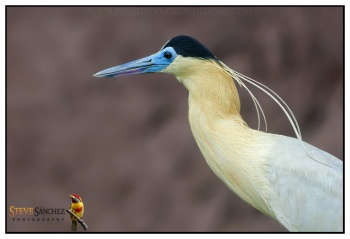m (Typo) |
(→References: Updated and expanded; honoring recommended citations. Removed irrelevant legacy ref.) |
||
| (4 intermediate revisions by 2 users not shown) | |||
| Line 1: | Line 1: | ||
| − | [[Image: | + | [[Image:IMG 63484.JPG|thumb|550px|right|Photo © by {{user|nick+scarle|nick scarle}}<br />Madre de Dios, [[Peru]], August 2018]] |
;[[:Category:Pilherodius|Pilherodius]] pileatus | ;[[:Category:Pilherodius|Pilherodius]] pileatus | ||
==Identification== | ==Identification== | ||
| − | + | [[Image:Iquitos and Allpahuayo Mishana.jpg|thumb|350px|right|Breeding colours<br />Photo © by {{user|Steve+Sanchez|Steve Sanchez}}<br />Río Mayo, Moyobamba, [[Peru]], October 2012]] | |
| + | 51–61 cm (20-24 in) <br /> | ||
*Yellow-white/cream plumage | *Yellow-white/cream plumage | ||
*Grey wings | *Grey wings | ||
| Line 15: | Line 16: | ||
Resident, possibly with some dispersal. | Resident, possibly with some dispersal. | ||
==Taxonomy== | ==Taxonomy== | ||
| − | This is a [[Dictionary_M- | + | This is a [[Dictionary_M-O#M|monotypic]] species<sup>[[#References|[1]]]</sup>. |
| + | |||
==Habitat== | ==Habitat== | ||
Swampy forest areas, ponds and streams, sometimes wet savanna. | Swampy forest areas, ponds and streams, sometimes wet savanna. | ||
| Line 21: | Line 23: | ||
==Behaviour== | ==Behaviour== | ||
====Diet==== | ====Diet==== | ||
| − | + | They mainly eat small fish, aquatic insects and frogs and tadpoles. | |
====Breeding==== | ====Breeding==== | ||
| − | + | There is very little known. Their stick nest is placed low in trees and their clutch consists of 2 eggs. | |
==References== | ==References== | ||
| − | #{{Ref- | + | #{{Ref-Clements6thAug18}}#[http://www.arthurgrosset.com/sabirds/capped%20heron.html Arthur Grosset] |
| − | # | + | #Martínez-Vilalta, A., Motis, A. & Kirwan, G.M. (2019). Capped Heron (Pilherodius pileatus). In: del Hoyo, J., Elliott, A., Sargatal, J., Christie, D.A. & de Juana, E. (eds.). Handbook of the Birds of the World Alive. Lynx Edicions, Barcelona. (retrieved from https://www.hbw.com/node/52673 on 22 July 2019). |
| + | #Buderman, F. E. (2010). Capped Heron (Pilherodius pileatus), version 1.0. In Neotropical Birds Online (T. S. Schulenberg, Editor). Cornell Lab of Ornithology, Ithaca, NY, USA. https://doi.org/10.2173/nb.capher1.01 | ||
{{ref}} | {{ref}} | ||
| + | |||
==External Links== | ==External Links== | ||
{{GSearch|Pilherodius+pileatus}} | {{GSearch|Pilherodius+pileatus}} | ||
[[Category:Birds]] [[Category:Pilherodius]] | [[Category:Birds]] [[Category:Pilherodius]] | ||
Latest revision as of 08:52, 22 July 2019
- Pilherodius pileatus
Identification
51–61 cm (20-24 in)
- Yellow-white/cream plumage
- Grey wings
- Cream-buff neck and breast
- Black cap
- Long white feathers at nape of neck
- Bright blue surrounding eyes and base of bill
- Cobalt blue bill
Distribution
South America where widespread in tropical areas. Breeds in eastern Panama and from Colombia and Venezuela to Paraguay and south-eastern Brazil.
Resident, possibly with some dispersal.
Taxonomy
This is a monotypic species[1].
Habitat
Swampy forest areas, ponds and streams, sometimes wet savanna.
Behaviour
Diet
They mainly eat small fish, aquatic insects and frogs and tadpoles.
Breeding
There is very little known. Their stick nest is placed low in trees and their clutch consists of 2 eggs.
References
- Clements, J. F., T. S. Schulenberg, M. J. Iliff, D. Roberson, T. A. Fredericks, B. L. Sullivan, and C. L. Wood. 2018. The eBird/Clements checklist of birds of the world: v2018. Downloaded from http://www.birds.cornell.edu/clementschecklist/download/
- Arthur Grosset
- Martínez-Vilalta, A., Motis, A. & Kirwan, G.M. (2019). Capped Heron (Pilherodius pileatus). In: del Hoyo, J., Elliott, A., Sargatal, J., Christie, D.A. & de Juana, E. (eds.). Handbook of the Birds of the World Alive. Lynx Edicions, Barcelona. (retrieved from https://www.hbw.com/node/52673 on 22 July 2019).
- Buderman, F. E. (2010). Capped Heron (Pilherodius pileatus), version 1.0. In Neotropical Birds Online (T. S. Schulenberg, Editor). Cornell Lab of Ornithology, Ithaca, NY, USA. https://doi.org/10.2173/nb.capher1.01
Recommended Citation
- BirdForum Opus contributors. (2024) Capped Heron. In: BirdForum, the forum for wild birds and birding. Retrieved 20 May 2024 from https://www.birdforum.net/opus/Capped_Heron





